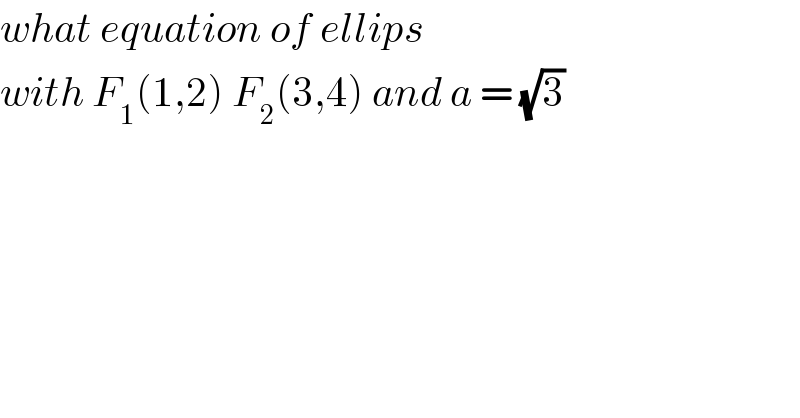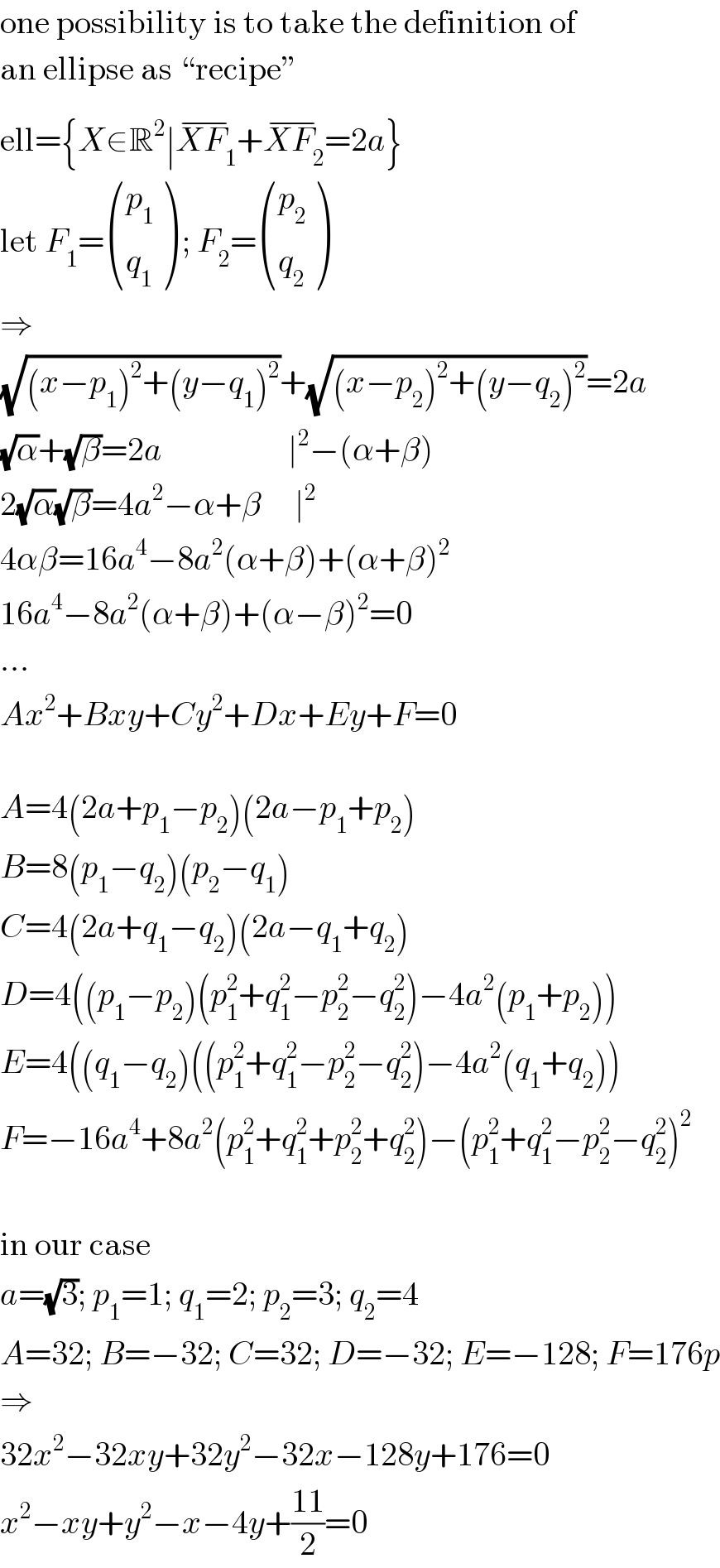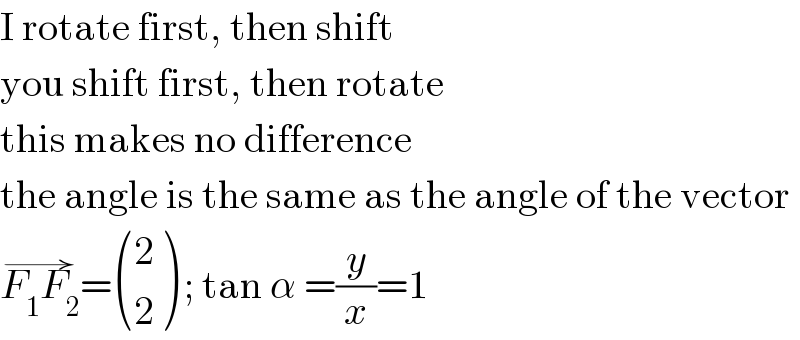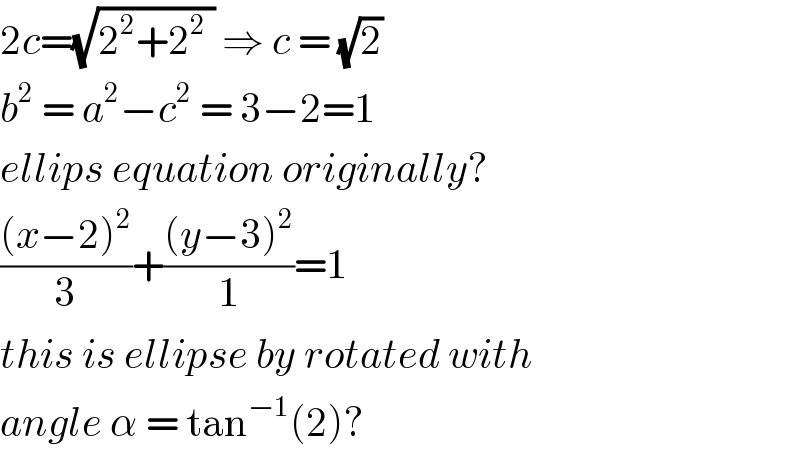
Question Number 78177 by jagoll last updated on 15/Jan/20

$${what}\:{equation}\:{of}\:{ellips} \\ $$$${with}\:{F}_{\mathrm{1}} \left(\mathrm{1},\mathrm{2}\right)\:{F}_{\mathrm{2}} \left(\mathrm{3},\mathrm{4}\right)\:{and}\:{a}\:=\:\sqrt{\mathrm{3}} \\ $$
Commented by MJS last updated on 15/Jan/20

$$\mathrm{what}\:\mathrm{are}\:\mathrm{we}\:``\mathrm{allowed}\:\mathrm{to}\:\mathrm{do}''? \\ $$
Commented by jagoll last updated on 15/Jan/20

$${yes}\:{sir}\:{i}\:{can}'{t}\:{solve}\:{this}\:{problem} \\ $$
Commented by jagoll last updated on 15/Jan/20

$${what}\:{is}\:{center}\:{point}\:{at}\:\left(\frac{\mathrm{1}+\mathrm{3}}{\mathrm{2}},\:\frac{\mathrm{2}+\mathrm{4}}{\mathrm{2}}\right)=\:\left(\mathrm{2},\mathrm{3}\right)\:{sir}? \\ $$
Commented by jagoll last updated on 15/Jan/20

Commented by MJS last updated on 15/Jan/20

$$\mathrm{one}\:\mathrm{possibility}\:\mathrm{is}\:\mathrm{to}\:\mathrm{take}\:\mathrm{the}\:\mathrm{definition}\:\mathrm{of} \\ $$$$\mathrm{an}\:\mathrm{ellipse}\:\mathrm{as}\:``\mathrm{recipe}'' \\ $$$$\mathrm{ell}=\left\{{X}\in\mathbb{R}^{\mathrm{2}} \mid\overline {{XF}_{\mathrm{1}} }+\overline {{XF}_{\mathrm{2}} }=\mathrm{2}{a}\right\} \\ $$$$\mathrm{let}\:{F}_{\mathrm{1}} =\begin{pmatrix}{{p}_{\mathrm{1}} }\\{{q}_{\mathrm{1}} }\end{pmatrix}\:;\:{F}_{\mathrm{2}} =\begin{pmatrix}{{p}_{\mathrm{2}} }\\{{q}_{\mathrm{2}} }\end{pmatrix} \\ $$$$\Rightarrow \\ $$$$\sqrt{\left({x}−{p}_{\mathrm{1}} \right)^{\mathrm{2}} +\left({y}−{q}_{\mathrm{1}} \right)^{\mathrm{2}} }+\sqrt{\left({x}−{p}_{\mathrm{2}} \right)^{\mathrm{2}} +\left({y}−{q}_{\mathrm{2}} \right)^{\mathrm{2}} }=\mathrm{2}{a} \\ $$$$\sqrt{\alpha}+\sqrt{\beta}=\mathrm{2}{a}\:\:\:\:\:\:\:\:\:\:\:\:\:\:\:\:\:\:\:\mid^{\mathrm{2}} −\left(\alpha+\beta\right) \\ $$$$\mathrm{2}\sqrt{\alpha}\sqrt{\beta}=\mathrm{4}{a}^{\mathrm{2}} −\alpha+\beta\:\:\:\:\:\mid^{\mathrm{2}} \\ $$$$\mathrm{4}\alpha\beta=\mathrm{16}{a}^{\mathrm{4}} −\mathrm{8}{a}^{\mathrm{2}} \left(\alpha+\beta\right)+\left(\alpha+\beta\right)^{\mathrm{2}} \\ $$$$\mathrm{16}{a}^{\mathrm{4}} −\mathrm{8}{a}^{\mathrm{2}} \left(\alpha+\beta\right)+\left(\alpha−\beta\right)^{\mathrm{2}} =\mathrm{0} \\ $$$$... \\ $$$${Ax}^{\mathrm{2}} +{Bxy}+{Cy}^{\mathrm{2}} +{Dx}+{Ey}+{F}=\mathrm{0} \\ $$$$ \\ $$$${A}=\mathrm{4}\left(\mathrm{2}{a}+{p}_{\mathrm{1}} −{p}_{\mathrm{2}} \right)\left(\mathrm{2}{a}−{p}_{\mathrm{1}} +{p}_{\mathrm{2}} \right) \\ $$$${B}=\mathrm{8}\left({p}_{\mathrm{1}} −{q}_{\mathrm{2}} \right)\left({p}_{\mathrm{2}} −{q}_{\mathrm{1}} \right) \\ $$$${C}=\mathrm{4}\left(\mathrm{2}{a}+{q}_{\mathrm{1}} −{q}_{\mathrm{2}} \right)\left(\mathrm{2}{a}−{q}_{\mathrm{1}} +{q}_{\mathrm{2}} \right) \\ $$$${D}=\mathrm{4}\left(\left({p}_{\mathrm{1}} −{p}_{\mathrm{2}} \right)\left({p}_{\mathrm{1}} ^{\mathrm{2}} +{q}_{\mathrm{1}} ^{\mathrm{2}} −{p}_{\mathrm{2}} ^{\mathrm{2}} −{q}_{\mathrm{2}} ^{\mathrm{2}} \right)−\mathrm{4}{a}^{\mathrm{2}} \left({p}_{\mathrm{1}} +{p}_{\mathrm{2}} \right)\right) \\ $$$${E}=\mathrm{4}\left(\left({q}_{\mathrm{1}} −{q}_{\mathrm{2}} \right)\left(\left({p}_{\mathrm{1}} ^{\mathrm{2}} +{q}_{\mathrm{1}} ^{\mathrm{2}} −{p}_{\mathrm{2}} ^{\mathrm{2}} −{q}_{\mathrm{2}} ^{\mathrm{2}} \right)−\mathrm{4}{a}^{\mathrm{2}} \left({q}_{\mathrm{1}} +{q}_{\mathrm{2}} \right)\right)\right. \\ $$$${F}=−\mathrm{16}{a}^{\mathrm{4}} +\mathrm{8}{a}^{\mathrm{2}} \left({p}_{\mathrm{1}} ^{\mathrm{2}} +{q}_{\mathrm{1}} ^{\mathrm{2}} +{p}_{\mathrm{2}} ^{\mathrm{2}} +{q}_{\mathrm{2}} ^{\mathrm{2}} \right)−\left({p}_{\mathrm{1}} ^{\mathrm{2}} +{q}_{\mathrm{1}} ^{\mathrm{2}} −{p}_{\mathrm{2}} ^{\mathrm{2}} −{q}_{\mathrm{2}} ^{\mathrm{2}} \right)^{\mathrm{2}} \\ $$$$ \\ $$$$\mathrm{in}\:\mathrm{our}\:\mathrm{case} \\ $$$${a}=\sqrt{\mathrm{3}};\:{p}_{\mathrm{1}} =\mathrm{1};\:{q}_{\mathrm{1}} =\mathrm{2};\:{p}_{\mathrm{2}} =\mathrm{3};\:{q}_{\mathrm{2}} =\mathrm{4} \\ $$$${A}=\mathrm{32};\:{B}=−\mathrm{32};\:{C}=\mathrm{32};\:{D}=−\mathrm{32};\:{E}=−\mathrm{128};\:{F}=\mathrm{176}{p} \\ $$$$\Rightarrow \\ $$$$\mathrm{32}{x}^{\mathrm{2}} −\mathrm{32}{xy}+\mathrm{32}{y}^{\mathrm{2}} −\mathrm{32}{x}−\mathrm{128}{y}+\mathrm{176}=\mathrm{0} \\ $$$${x}^{\mathrm{2}} −{xy}+{y}^{\mathrm{2}} −{x}−\mathrm{4}{y}+\frac{\mathrm{11}}{\mathrm{2}}=\mathrm{0} \\ $$
Commented by MJS last updated on 15/Jan/20

$$...\mathrm{you}\:\mathrm{are}\:\mathrm{right}\:\mathrm{with}\:\mathrm{the}\:\mathrm{center}\:\mathrm{point} \\ $$
Commented by MJS last updated on 15/Jan/20

$$\mathrm{the}\:\mathrm{other}\:\mathrm{possibility}\:\mathrm{is}\:\mathrm{to}\:\mathrm{calculate}\:{b} \\ $$$${e}=\frac{\mathrm{1}}{\mathrm{2}}\overline {{F}_{\mathrm{1}} {F}_{\mathrm{2}} }=\sqrt{\mathrm{2}} \\ $$$${b}=\sqrt{{a}^{\mathrm{2}} −{e}^{\mathrm{2}} }=\mathrm{1} \\ $$$$\mathrm{the}\:\mathrm{equation}\:\mathrm{of}\:\mathrm{the}\:\mathrm{ellipse}\:\mathrm{similar}\:\mathrm{to}\:\mathrm{the} \\ $$$$\mathrm{given}\:\mathrm{one}\:\mathrm{but}\:\mathrm{with}\:\mathrm{center}\:\mathrm{in}\:\begin{pmatrix}{\mathrm{0}}\\{\mathrm{0}}\end{pmatrix}\:\mathrm{and}\:\mathrm{axes} \\ $$$$\mathrm{parallel}\:\mathrm{to}\:{x}−\:\mathrm{and}\:{y}−\mathrm{axes}\:\mathrm{is} \\ $$$$\frac{{x}^{\mathrm{2}} }{\mathrm{3}}+\frac{{y}^{\mathrm{2}} }{\mathrm{1}}=\mathrm{1} \\ $$$${x}^{\mathrm{2}} +\mathrm{3}{y}^{\mathrm{2}} −\mathrm{3}=\mathrm{0} \\ $$$$\mathrm{now}\:\mathrm{we}\:\mathrm{have}\:\mathrm{to}\:\mathrm{rotate}\:\mathrm{and}\:\mathrm{shift}\:\mathrm{it} \\ $$$$\theta=\measuredangle\left(\overset{\rightarrow} {{F}_{\mathrm{1}} {F}_{\mathrm{2}} }\right)=\mathrm{45}° \\ $$$$\Rightarrow\:\begin{cases}{{x}^{\ast} =\frac{\sqrt{\mathrm{2}}}{\mathrm{2}}\left({x}−{y}\right)}\\{{y}^{\ast} =\frac{\sqrt{\mathrm{2}}}{\mathrm{2}}\left({x}+{y}\right)}\end{cases}\:\Leftrightarrow\:\begin{cases}{{x}=\frac{\sqrt{\mathrm{2}}}{\mathrm{2}}\left({x}^{\ast} +{y}^{\ast} \right)}\\{{y}=\frac{\sqrt{\mathrm{2}}}{\mathrm{2}}\left({y}^{\ast} −{x}^{\ast} \right)}\end{cases} \\ $$$$\mathrm{inserting}\:\mathrm{into}\:\mathrm{our}\:\mathrm{equation} \\ $$$$\mathrm{2}\left({x}^{\ast} \right)^{\mathrm{2}} −\mathrm{2}{x}^{\ast} {y}^{\ast} +\mathrm{2}\left({y}^{\ast} \right)^{\mathrm{2}} −\mathrm{3}=\mathrm{0} \\ $$$$\mathrm{shifting}\:\mathrm{the}\:\mathrm{center} \\ $$$$\begin{cases}{{x}^{\ast} ={x}−\mathrm{2}}\\{{y}^{\ast} ={y}−\mathrm{3}}\end{cases} \\ $$$$\mathrm{2}{x}^{\mathrm{2}} −\mathrm{2}{xy}+\mathrm{2}{y}^{\mathrm{2}} −\mathrm{2}{x}−\mathrm{8}{y}+\mathrm{11}=\mathrm{0} \\ $$$${x}^{\mathrm{2}} −{xy}+{y}^{\mathrm{2}} −{x}−\mathrm{4}{y}+\frac{\mathrm{11}}{\mathrm{2}}=\mathrm{0} \\ $$
Commented by jagoll last updated on 15/Jan/20

$${sir}\:{why}\:{center}\:{point}\:{at}\:\left(\mathrm{0},\mathrm{0}\right)\:? \\ $$$${and}\:{i}\:{got}\:{the}\:{angle}\:\alpha\:=\:\mathrm{tan}^{−\mathrm{1}} \left(\mathrm{2}\right).\:{where} \\ $$$${i}'{m}\:{wrong}\:{sir}? \\ $$
Commented by MJS last updated on 15/Jan/20

$$\mathrm{I}\:\mathrm{rotate}\:\mathrm{first},\:\mathrm{then}\:\mathrm{shift} \\ $$$$\mathrm{you}\:\mathrm{shift}\:\mathrm{first},\:\mathrm{then}\:\mathrm{rotate} \\ $$$$\mathrm{this}\:\mathrm{makes}\:\mathrm{no}\:\mathrm{difference} \\ $$$$\mathrm{the}\:\mathrm{angle}\:\mathrm{is}\:\mathrm{the}\:\mathrm{same}\:\mathrm{as}\:\mathrm{the}\:\mathrm{angle}\:\mathrm{of}\:\mathrm{the}\:\mathrm{vector} \\ $$$$\overset{\rightarrow} {{F}_{\mathrm{1}} {F}_{\mathrm{2}} }=\begin{pmatrix}{\mathrm{2}}\\{\mathrm{2}}\end{pmatrix}\:;\:\mathrm{tan}\:\alpha\:=\frac{{y}}{{x}}=\mathrm{1} \\ $$
Commented by jagoll last updated on 15/Jan/20

$${yes}\:{sir}.\:{thanks} \\ $$
Answered by jagoll last updated on 15/Jan/20

$$\mathrm{2}{c}=\sqrt{\mathrm{2}^{\mathrm{2}} +\mathrm{2}^{\mathrm{2}} \:}\:\Rightarrow\:{c}\:=\:\sqrt{\mathrm{2}} \\ $$$${b}^{\mathrm{2}} \:=\:{a}^{\mathrm{2}} −{c}^{\mathrm{2}} \:=\:\mathrm{3}−\mathrm{2}=\mathrm{1} \\ $$$${ellips}\:{equation}\:{originally}? \\ $$$$\frac{\left({x}−\mathrm{2}\right)^{\mathrm{2}} }{\mathrm{3}}+\frac{\left({y}−\mathrm{3}\right)^{\mathrm{2}} }{\mathrm{1}}=\mathrm{1} \\ $$$${this}\:{is}\:{ellipse}\:{by}\:{rotated}\:{with} \\ $$$${angle}\:\alpha\:=\:\mathrm{tan}^{−\mathrm{1}} \left(\mathrm{2}\right)? \\ $$
Commented by MJS last updated on 15/Jan/20

$$\mathrm{angle}\:\alpha=\mathrm{tan}^{−\mathrm{1}} \:\left(\mathrm{1}\right)\:=\mathrm{45}° \\ $$
Commented by MJS last updated on 15/Jan/20

$$...\mathrm{you}\:\mathrm{should}\:\mathrm{get}\:\mathrm{the}\:\mathrm{same}\:\mathrm{result}\:\mathrm{as}\:\mathrm{me}.\:\mathrm{you} \\ $$$$\mathrm{shift}\:\mathrm{first},\:\mathrm{then}\:\mathrm{rotate} \\ $$
Commented by jagoll last updated on 15/Jan/20

$${oo}\:\mathrm{tan}\:\alpha\:=\frac{\mathrm{4}−\mathrm{2}}{\mathrm{3}−\mathrm{1}}=\mathrm{1}\:.\:{oo}\:{i}\:{understand}\: \\ $$$${sir}.\:{thanks}\:{you}\:{very}\:{much} \\ $$
